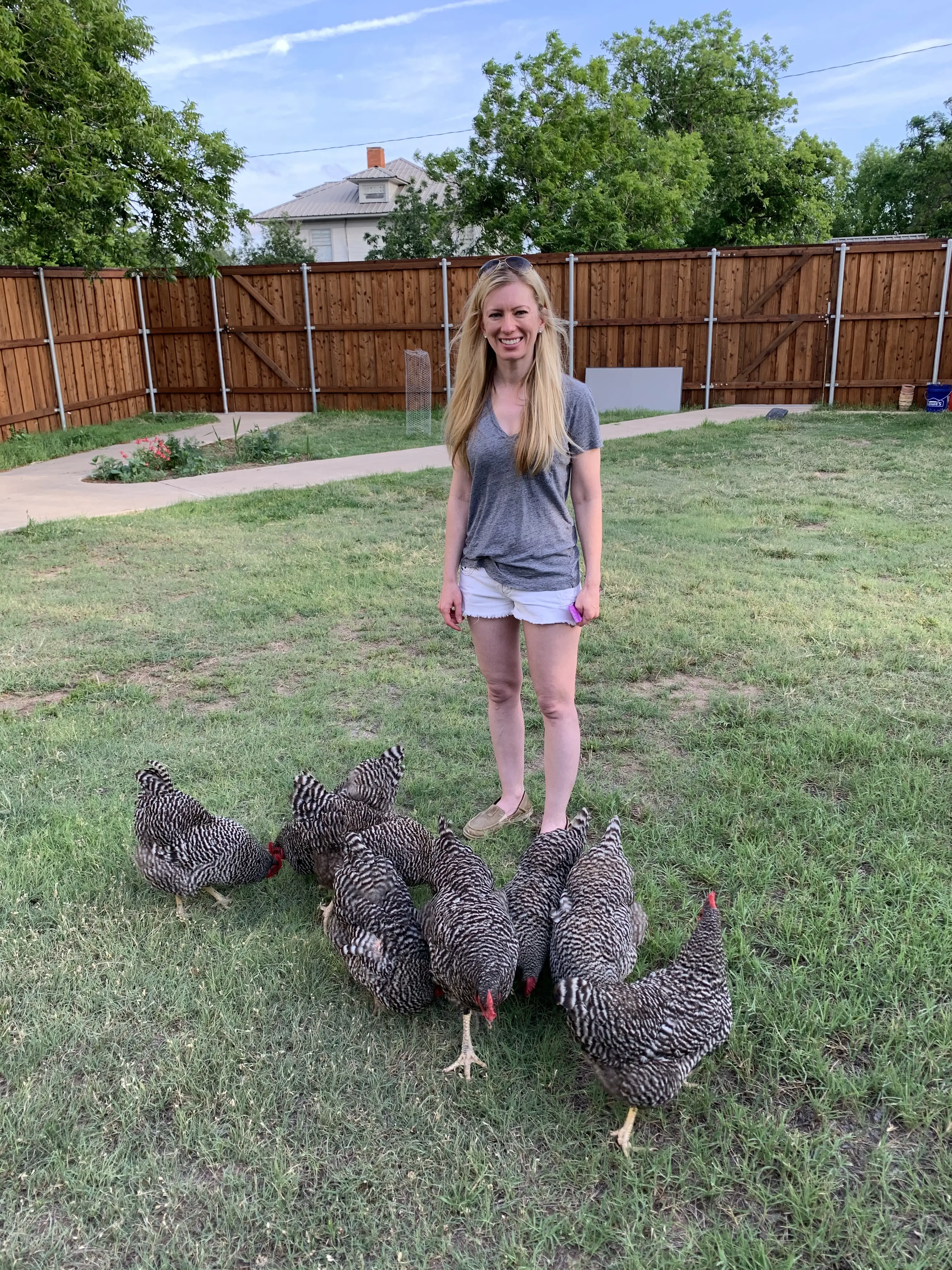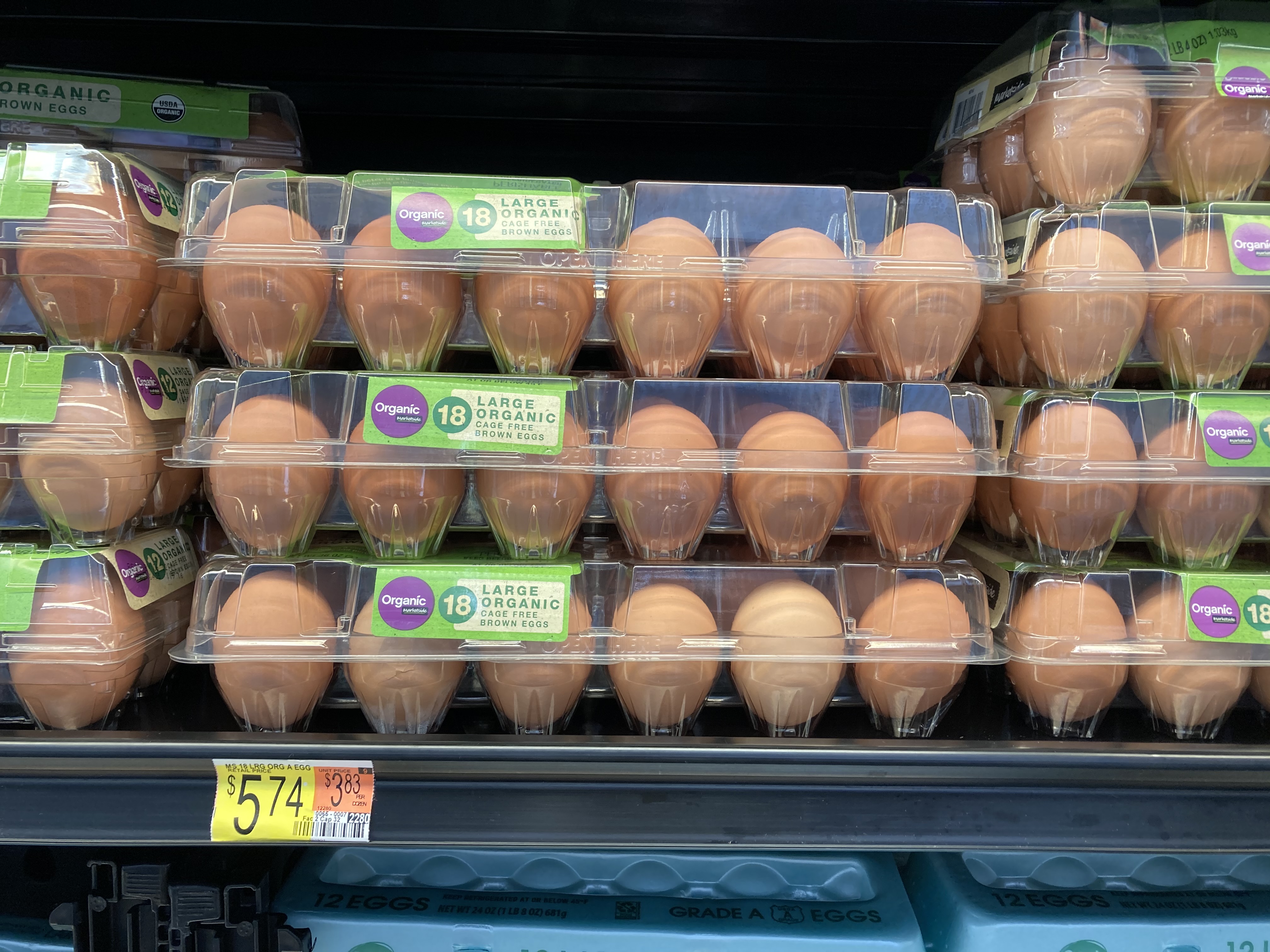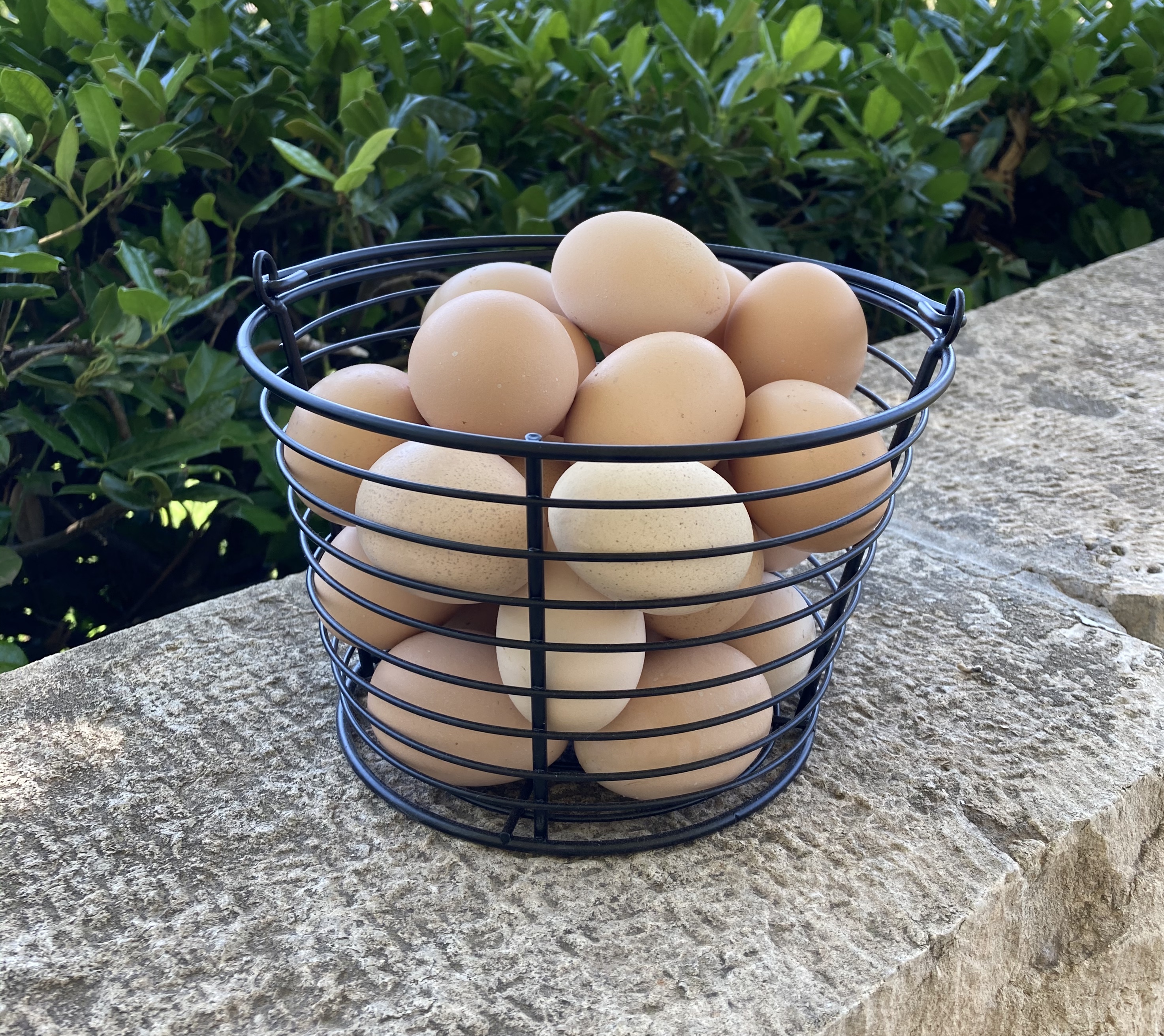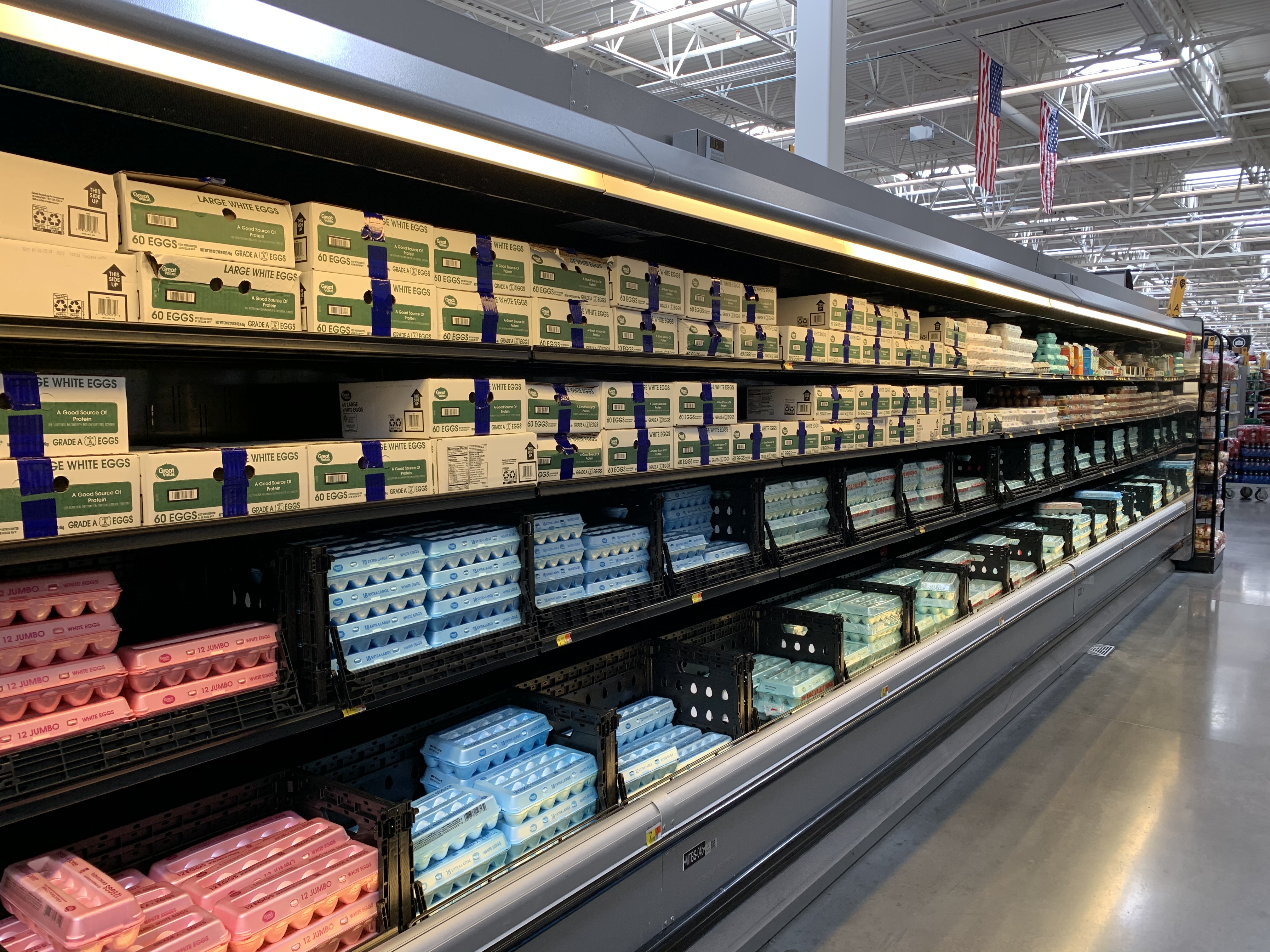The cost of raising chickens versus buying eggs includes more than just what you will pay for 1 dozen eggs. There are other costs, or factors, to consider such as the living conditions of the chickens, the transportation of the eggs, and the affect on the land. In addition, there is a difference in the level of involvement you will have in your food production and the knowledge of what is going into your body.
On average, it costs $603 per year and $1,830 in one-time expenses to raise a flock of 10 chickens. These chickens could be capable of producing 216 dozen eggs per year, or roughly $11 per dozen in the first year. By comparison store bought eggs cost $6 per dozen.
There are several factors to understand when it comes to comparing raising chickens for eggs versus buying eggs from the store. Read on to see a breakdown of 4 factors to consider.
Cost of Living Conditions of the Chickens
“Backyard chickens” will be defined in this post as chickens that are raised on a small scale, typically in someone’s backyard, where the intent is more on having the chickens as pets rather than having the chickens produce eggs for profit.
People who raise chickens at home will have anywhere from 3 to 30 chickens, depending on the space they have available and the resources to raise the chickens. These chickens are raised mostly as pets and when they reach an age where egg production is diminished, the chickens will continue to be kept as pets and not end up on the dinner table.
This post provides a breakdown of expenses related to raising chickens in your backyard.
Chickens raised industrially can include chickens raised in a factory chicken house or those that are raised by the hundreds in a pasture setting. These birds are not pets and their sole purpose is to produce eggs that will be sold at a grocery store. For the purposes of this post, I will identify these types of chickens as “factory chickens.”
Since many people who keep chickens in their backyards view them as pets, these birds receive a significant amount of human interaction. Their owners will let them out of the coop in the morning and shut the door at night. Chickens recognize their owners and even respond if they are named.

Backyard chickens are usually fed a mixture of feed and kitchen scraps. Their diet is varied and can be seen in the varying sizes of their eggs. When chickens free range–meaning they forage for bugs and plants in a yard–their egg yolks will be a more vibrant orange color and taste richer.
Egg shell color is determined by breed of chicken, so backyard chickens can lay eggs with white, brown, or even blue shells. Shell color has no impact on flavor of eggs, but is more an aesthetic feature where some people prefer a certain color of egg.
Many chickens will start laying eggs around 18 to 22 weeks, with heavier breeds starting at 24 to 26 weeks. Their egg production usually starts to decline around 2 or 3 years.
When backyard chickens have a decline in egg production, many people will continue to keep the chickens as pets. The average lifespan of a backyard chicken is 8 years, but well cared for chickens can live up to 15 years.
Factory chickens are raised for the sole purpose of producing eggs at the lowest cost. These birds will live in very cramped quarters, including the chickens that are allowed to be in pastures.
The eggs from these chickens are sometimes called “cage free,” “pasture raised,” or “free range.” However, this is a misnomer and a internet search can show you many photos of their actual living conditions. The factory chickens are fed by automatic feeder or conveyor belt.
When they lay eggs, the eggs are dropped down a ramp and onto a conveyor to prevent the chickens from cracking the eggs or sitting on the eggs to try to hatch. Since only hens are able to lay eggs, male chickens are not needed and are often killed after hatching.

Factory chickens are usually White Leghorns, which lay white eggs, or Rhode Island Reds, which lay brown eggs, or some genetically selected version of those breeds that has been optimized for high egg productivity.
When factory chickens have a decline in egg production at around 2 years, they are considered to be spent and will be culled (or selectively killed). It is not cost effective to continue feeding a chicken after its peak egg production has started to decline and the purpose of the factory chicken is for the industrial production of eggs. The typical maximum lifespan of a factory chicken is 2 years.
Cost of Transporting & Processing of Eggs
The transporting and processing of eggs from a backyard chicken is relatively straightforward. Chickens lay eggs every 25 hours so a chicken keeper will check the nest boxes at least once a day to collect eggs. These eggs are then immediately ready for consumption. Eggs can be stored in a wire basket or egg cartons and then used by the family or sold.

When eggs from a backyard chicken are collected, they are not washed until prior to consumption to maintain the bloom on the egg. Immediately before a chicken lays an egg, she deposits a bloom, or a clear wet layer, on the egg to protect it from bacteria and keep it naturally fresh.
When the eggs are washed and the bloom is removed, it is easier for bacteria to enter the pores of the egg. Eggs from backyard chickens that have the bloom intact do not need to be refrigerated. The eggs can stay out safely for several weeks; however, refrigerated eggs will remain fresher for longer (up to several months). I wrote this post about when to wash eggs and when it’s ok to skip the wash.
In the example from earlier, the 10 chickens produced 216 dozen eggs per year (averaging 260 eggs per chicken). For most families, this is more eggs than can be consumed so the excess can be sold. Assuming a family eats 1 dozen eggs a week, that means there are 164 dozen eggs that can be sold. If these eggs are sold at $5 per dozen that equates to $820 per year in egg sales. When this amount is subtracted from the cost of raising chickens, the cost of a dozen of eggs from a backyard chicken drops to $7.50 per dozen.
The collection, storage, and transportation of eggs from a factory chicken is much more involved. Depending on the type of factory farm, the eggs are collected and then either processed at the same facility or transported to a separate location for processing. The “sell by date” on a carton of eggs is set from the date of processing, not from when the chicken laid the egg.
After a chicken lays an egg, it is collected by machine and handled with automated equipment. In the United States, all eggs are required to be washed before they can be sold to consumers.
Commercial producers will spray mineral oil on the eggs to replace the natural bloom that was washed off. This also helps with the marketing of the eggs at the grocery store as it makes them more shiny and appealing to consumers. Eggs will be graded, weighed, sorted, washed, dried, and packaged.
During transportation to the stores, eggs must be kept at a core temperature of 45 degrees F. Once at the store, the eggs are put in the display refrigerators for customers to buy. After purchase the eggs must remain refrigerated to reduce the growth of bacteria.

Cost of Effect on Environment
Chickens raised in the backyard positively contribute to the local ecology. Many people who raise chickens will also grow their own gardens.
The manure from the chickens and the bedding from their coops can be composted and eventually added to the garden. Compost in a garden increases the yield of the plants naturally without the use of chemicals. The plants from the garden can then be fed to the chickens, either directly or from kitchen scraps.
When chickens are allowed to free range, they will scratch the ground to look for bugs and plants to eat. The scratching can help naturally kill weeds in a yard; however, the scratching can tear up a lawn so care needs to be taken when allowing chickens to free range in a manicured lawn or near a flower bed or garden. Chickens will also eat many of the bugs found in a garden, such as worms, termites, beetles, and spiders; therefore, serving as natural pest control.
Backyard chickens are housed in a chicken coop, typically the size of a small shed or a child’s playhouse. Many people will have a chicken run, or caged enclosure, attached to their chicken coops to allow chickens a place to be outside while being protected from predators. The cost of utilities for a backyard chicken coop are negligible as there is usually no electricity and the water from the water hose is added to the overall water bill for the house.

The environmental footprint of factory chickens is very large in comparison to backyard chickens. Factories for chickens can be the size of football fields and take up many acres of land. Some of the larger chicken factory farms can house tens of thousands of chickens, while the smaller farms run by families will only have a few thousand chickens at a time.
The factory farms are typically in rural areas and require paved roads capable of maintaining trucks transporting chickens, eggs, equipment, and employees. Since these farms house so many chickens, the overhead costs are much greater; thus the need to only have chickens that are high producers of eggs.
The manure from the factory chickens will have many uses. In some instances, the manure is spread over nearby fields. It can also be converted to pelletized fertilizer, fed to cattle, and converted to biodiesel.
Housing for chickens will have an odor if it is not properly cleaned and maintained. Backyard chicken coops are typically cleaned twice a year and will have additional bedding added as necessary. This bedding absorbs odors from manure and can then be added to the compost pile.
Factory farms have significantly more chickens and, therefore, significantly more odor. An ammonia odor results when there is an excess of chicken manure and seems to be worse in hot weather. This odor can be an issue for neighbors of factory farms if they are downwind. The ammonia odor can also cause “ammonia burn” and respiratory illness for factory chickens.
Cost of Involvement in Your Food Production
Large scale chicken factory farms came to existence in the 1950s after the World Wars. Before this time, it was not usual for many Americans to have chickens at home or on the farm that would provide their family with eggs and meat. Over the past 70 years, many people have lost the connection people once had with their food and how it ends up on the dinner table.
Many adults today are not even aware that only female chickens (hens) lay eggs and that a rooster is not needed for a chicken to lay an egg. Raising chickens in your backyard allows everyone in the family to understand what is required for an egg to be produced. Children learn about taking care of chickens and the chores that are required every day at dawn and dusk. Raising animals helps children and adults alike to have compassion for the animals and to understand the stewardship involved in agriculture.
With backyard chickens, you know exactly what the chickens are eating. Most of the time they eat a feed that is specially formulated for their age and nutritional requirements (for example, a layer feed is fed to chickens that are at the age of laying eggs). Backyard chickens will forage in the yard and get kitchen scraps. They will have access to water throughout the day and generally live stress-free lives.
Many people will raise their chickens from the moment or day after the chickens hatch, so they know everything the chicken has ever eaten. If you raise your own chickens, you can make the decision if they receive pharmaceuticals, like antibiotics.
In factory farm settings, laying chickens are viewed solely as producers of eggs. When they have peaked with laying production, the chickens are culled and a new batch of chickens will go through the same process. Factory chickens do not have access to kitchen scraps and generally do not go outside the shed where they live (even though it might be “cage free”). Most factory farmers will feed all their chickens antibiotics to prevent illnesses, whether the chickens are sick or not.
If you don’t raise backyard chickens, then consider buying eggs from someone who does. Raising chickens in the backyard gained popularity in the 1960s and 1970s, waning in the 1980s, and has recently made a comeback. It’s popular among people who want to be closer to their food source and others who find the companionship of chickens to be enriching to their lives. Depending on where you live, you most likely won’t have to look too hard to find a neighbor, co-worker, or family member who raises chickens.
While this post focused on laying birds, there are similar factors to consider for broilers (chickens that are raised for meat).
References:
https://cias.wisc.edu/2003/01/01/large-scale-pastured-poultry-farming-in-the-us/

